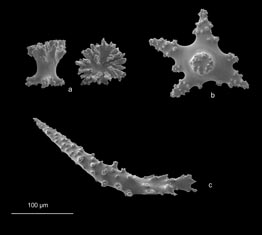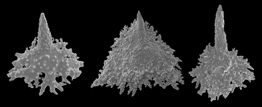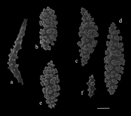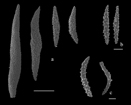CONTENTS
Introduction
The South Atlantic Bight
Methods
Octocoral Morphology
Glossary
Gorgonacean
Bauplan
Key to the Families of Octocorals in the South Atlantic Bight
Key to the Species of
Clavulariidae
Anthothelidae
Plexauridae
Gorgoniidae
Virgulariidae
Notes on the Species
Carijoa
riisei
Scleranthelia
rugosa
Telesto fruticulosa
Telesto nelleae
Telesto sanguinea
Bellonella rubistella
Pseudodrifa nigra
Nidalia occidentalis
Iciligorgia schrammi
Diodogorgia
nodulifera
Titanideum
frauenfeldii
Muricea pendula
Thesea nivea
Bebryce grandis
Bebryce parastellata
Scleracis guadalupensis
Placogorgia sp.
Leptogorgia hebes
Leptogorgia punicea
Leptogorgia
cardinalis
Leptogorgia virgulata
Leptogorgia setacea
Leptogorgia euryale
Ctenocella (Ellisella)
barbadensis
Renilla reniformis
Sclerobelemnon
theseus
Stylatula elegans
Virgularia presbytes
| Subclass
OCTOCORALLIA (=ALCYONARIA) Order Alcyonacea Suborder Holaxonia Octocorals with unspiculated axis and often a soft,
chambered central core. Family Plexauridae Members of the families Paramuriceidae and Muriceidae were reclassified in Bayer 1981 to Plexauridae. Members of this family in the SAB have an unspiculated, horny axis and a hollow, axial core surrounded by a loculated cortex. Generally the calyces have a strong armature of sclerites. |
|
Key to species of Plexauridae in the shallow
(to 200m) South Atlantic Bight |
|
| 1a. – Sclerites of colonies include warty stellate plates with a central knob as well as cup-shaped rosettes in outer cortex, with concavity of cup facing away from axis....................................2
Sclerites of Bebryce parastellata. top left: cup shaped rosettes from outer cortex; top right: stellate plate with central knob; bottom: rod. Image courtesy S. Cairns (Smithsonian/NMNH)
|
1b. – Sclerites of colonies include spindles, granules, rods or thorn-scales but no cup-shaped rosettes in outer cortex.........................................3
top: Placogorgia sp. thorn-scales; bottom left: Thesea nivea spindles; bottom right: Scleracis guadalupensis spindles |
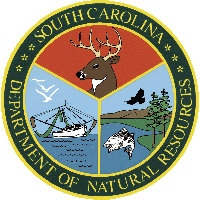 |
